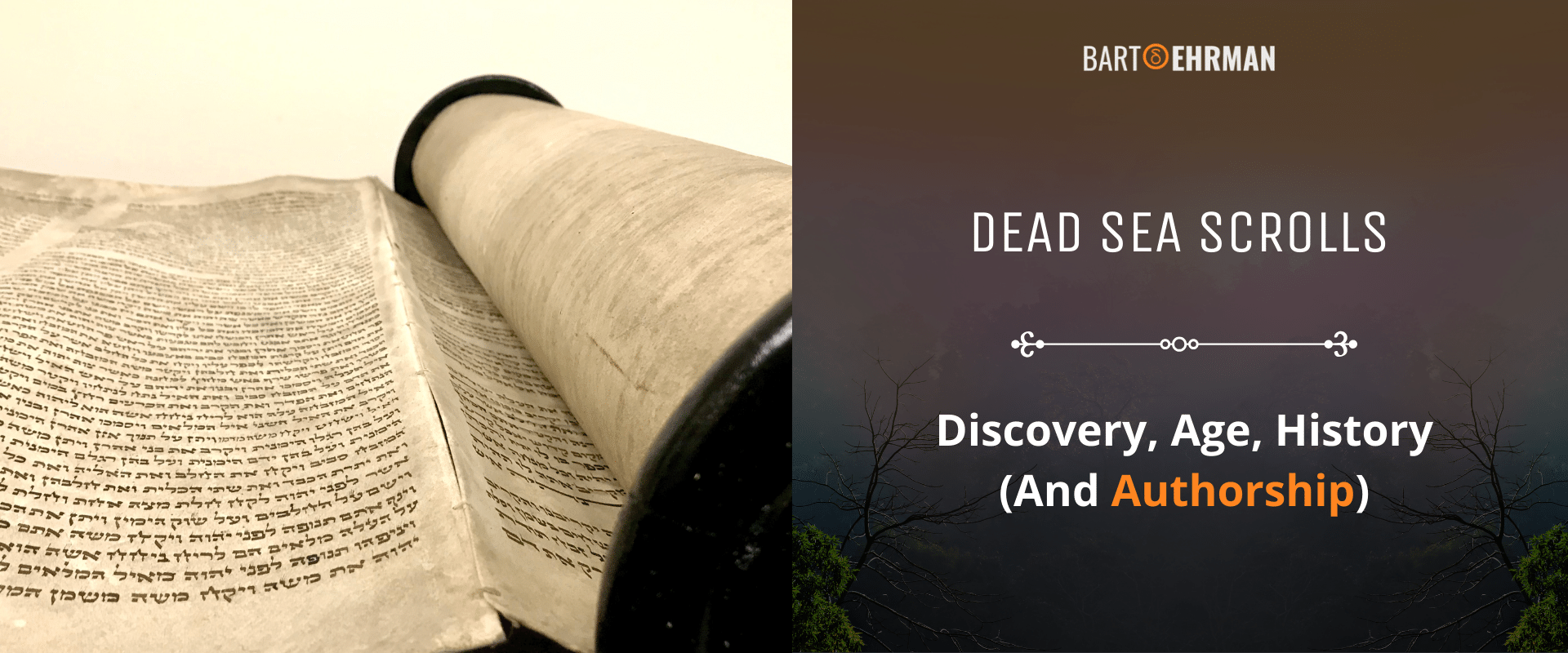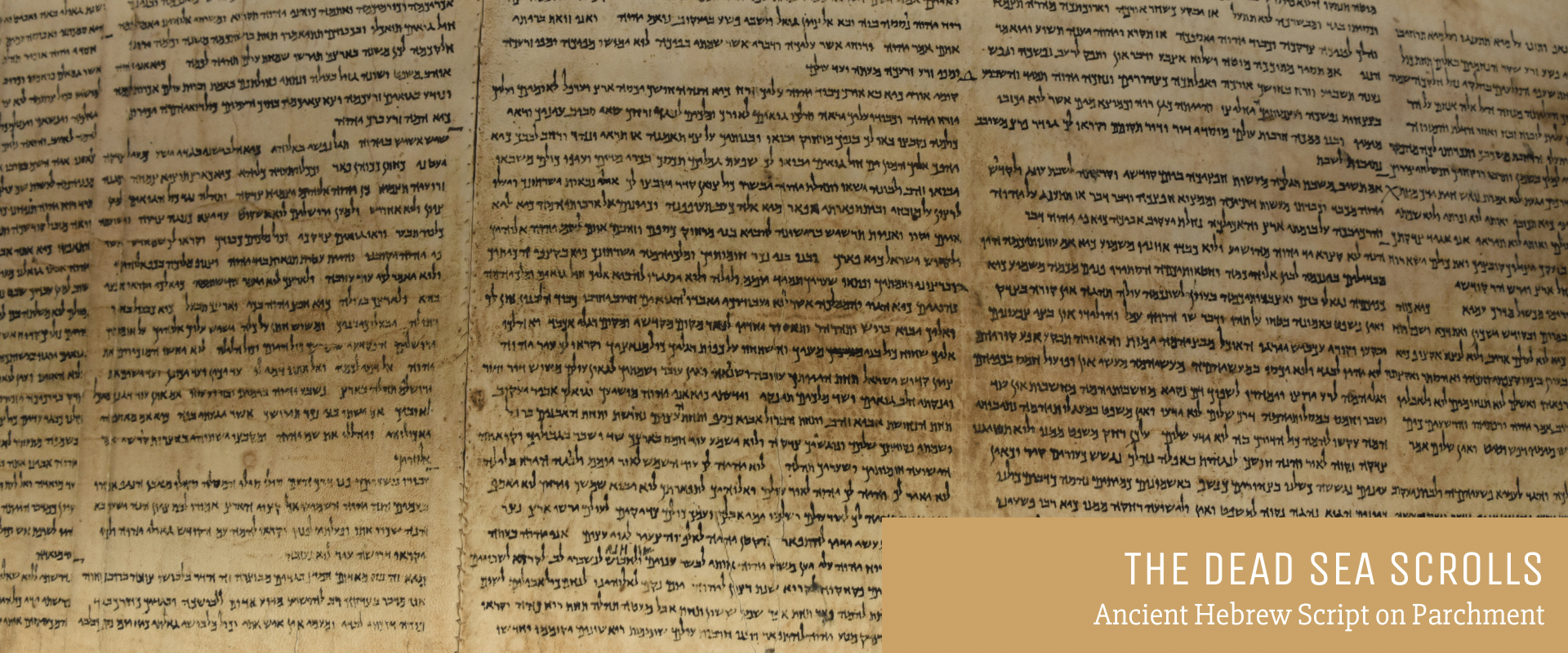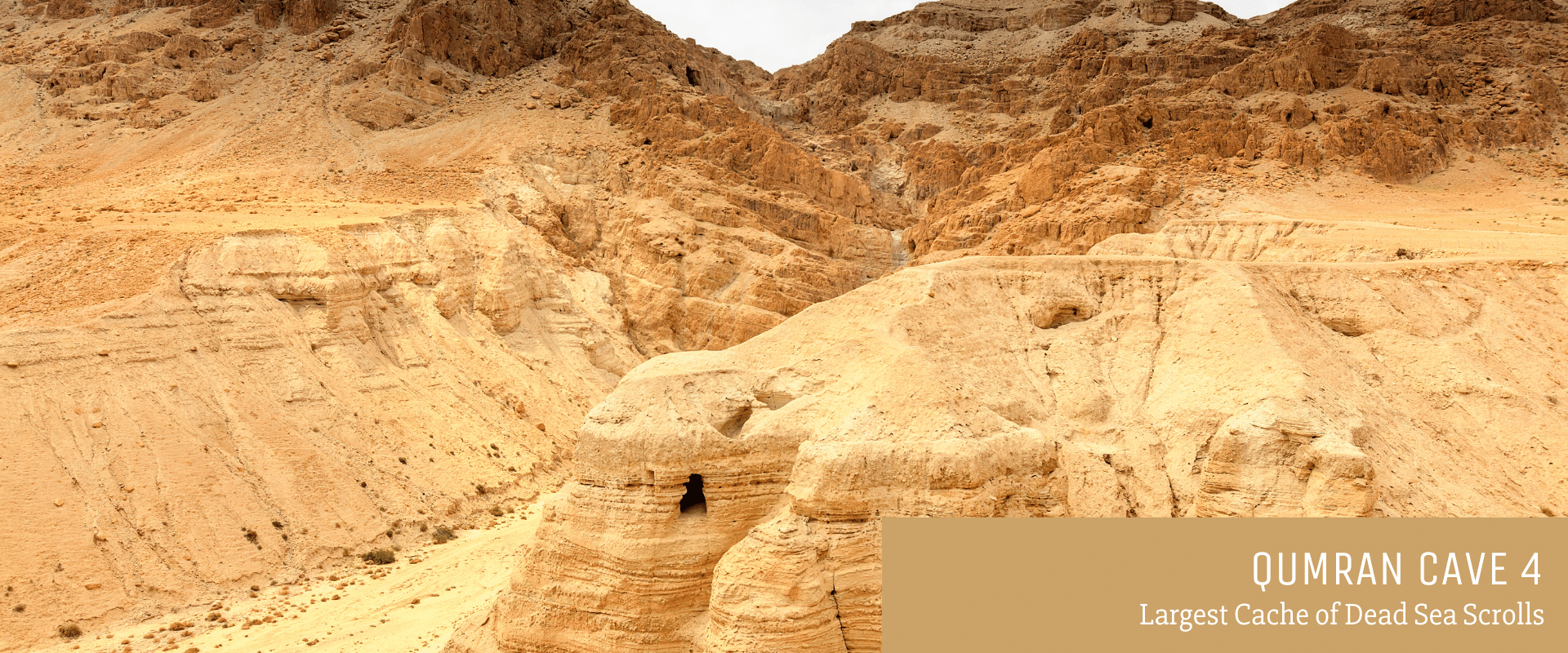Dead Sea Scrolls: Discovery, Age, History (And Authorship)

Written by Joshua Schachterle, Ph.D
Author | Professor | Scholar
Author | Professor | BE Contributor
Verified! See our editorial guidelines
Verified! See our guidelines
Date written: May 11th, 2024
Disclaimer: The views and opinions expressed in this article belong to the author and do not necessarily match my own. - Dr. Bart D. Ehrman
The Dead Sea Scrolls are one of the most significant archeological discoveries ever made in Palestine. But what are the Dead Sea Scrolls? Where did they come from? What is the historical and religious significance of these texts?
While the texts are certainly Jewish, they also give us some interesting context for the beginning of Christianity, since they were likely written around the same time as the life of Jesus. In this article, I’ll give you some details about the scrolls, tell you about their discovery and history, and even discuss their contents.

What Are the Dead Sea Scrolls?
The Dead Sea Scrolls are a collection of ancient Jewish documents discovered in caves in an area called Qumran, a desert region in the West Bank about a mile from the Dead Sea and about thirty miles east of Jerusalem.
You can see digital images of the original manuscripts as they’ve been preserved in the Israel Museum in Jerusalem at this website. I highly recommend looking at this site, as the images really show what the documents are like and how they were painstakingly created by hand. In addition, you can read a (very long) PDF file of the English translation of the scrolls for free here.
To date, 981 scrolls and fragments have been found and preserved by researchers in 11 different caves. Most were found in 1946-47 with some additional texts in 1956. Of the 11 caves in which manuscripts have been found, Cave 4 had the largest number of scrolls (see image of Cave 4 below). The caves are near a Hellenistic Jewish settlement known as Khirbet Qumran which was occupied between 150 BCE and 70 CE.

The vast majority of the writings – about eighty percent – are in Hebrew. However, there are also writings in Aramaic, Greek, and the much rarer Nabatean language. Researchers have used carbon dating and paleography (the study of ancient manuscripts), both of which prove that the scrolls were written over a long period, probably from the 2nd century BCE to the 1st century CE.
These scrolls are incredibly important historically. They give us clues about the community that produced them, what that community valued, and their religious ideas they held, many of which stood outside the mainstream Judaism of the Greco-Roman period.
Do the Dead Sea Scrolls mention Jesus? No, these are deeply Jewish texts. However, while they are certainly not Christian documents, some of them may have been produced during Jesus’ lifetime and the establishment of the early church.
When and Where Were the Dead Sea Scrolls Found?
The story of the accidental discovery of the Dead Sea Scrolls is interesting. Archeologist John C. Trever did extensive interviews with the people involved in finding the scrolls. They were discovered first by Arab shepherds Muhammed edh-Dhib, Jum'a Muhammed, and Khalil Musa between November 1946 and February 1947.
Edh-Dhib apparently stumbled into one of the Qumran caves by accident and discovered a large water jar, its top sealed with wax. Breaking the seal, Edh-Dhib found a handful of scrolls inside which he took back to show his family. After he and his family discussed what to do with them, edh-Dhib eventually took them to an antiquities dealer named Ibrahim 'Ijha in Bethlehem. ‘Ijha returned them, telling edh-Dhib they were worthless.
Rather than giving up, edh-Dhib took them to a nearby market where a Syrian Christian offered to buy them. Another person overheard what they were talking about and suggested taking them to an expert he knew to have them evaluated. The “expert” was Khalil Eskander Shahin, a cobbler by trade who also dabbled in antiques. Edh-Dhib left one scroll with Shahin and sold three others to a dealer for the equivalent of $28.
John Trever himself found out about the scrolls in 1947 and was able to examine them. He compared them with the oldest Hebrew Bible manuscript known at that time, the Nash Papyrus which was dated to 150-100 BCE, and discovered that the writing style was very similar, indicating that the scrolls were at least that old. Thus in 1948, the head of the American Schools of Oriental Research (ASOR), of which Trever was a prominent member, announced the discovery of the scrolls to the mainstream press.
Between 1949 and 1951, the cave which edh-Dhib had initially fallen into was heavily excavated by ASOR, yielding many more scrolls. This cave would come to be known as Cave 1 by archeologists who would eventually find 10 more caves containing scrolls.
From 1951-1956, more excavations continued at Qumran, again organized by ASOR. Cave 11 was discovered in 1956 and the last fragment of a scroll was found there. Another cave was discovered and excavated in 2017. Although it was evident that scrolls had been stored there, researchers discovered that they had all been removed by looters sometime in the 1950s.
FREE COURSE!
WHY I AM NOT A CHRISTIAN
Raw, honest, and enlightening. Bart's story of why he deconverted from the Christian faith.
Over 6,000 enrolled!
Who Wrote the Dead Sea Scrolls?
The Qumran scrolls were written by a Jewish separatist community, which I’ll simply call the Qumran community, during the Second Temple period. Many think this community was a group called the Essenes, who I’ll talk about below. Remains of their settlement, Khirbet Qumran, can be found near the Dead Sea’s northwest shore. At this settlement, archeologists have found coins and pottery which, according to the Encyclopaedia Judaica, show that the group inhabited it from the beginning of the 2nd century BCE to 70 CE when the Second Temple was destroyed in Jerusalem.
When authors of the scrolls refer to their community they call it yahad, Hebrew for “unity.” In this section I’ll discuss who these people were, the basis for their community, and what the scrolls reveal about them. Later I’ll explore scholarly theories about who they were as well.
What Was the Basis for the Qumran Community?
It’s evident from the writing in the scrolls that the community took a dim view of the established Jewish religious authorities of their time. They believed that God would ultimately judge these authorities harshly and that the yahad were the true Israel who would be righteously vindicated at the end of days. In other words, their beliefs were apocalyptic, a common orientation during this period of Jewish history.
One of their main complaints was that the Jerusalem priesthood had been corrupted, thereby losing God’s favor. The community had therefore cut themselves off completely from the Jerusalem temple cult, ensconcing themselves far outside Jerusalem to establish a new, purer form of Judaism. Among their purity requirements, by the way, was enforced celibacy.
In fact, the group might be called proto-monastic in that they were a closed religious community who had manuals of discipline and routines by which they were required to live in order to achieve and maintain the necessary ritual and moral purity.
In common with other apocalyptic groups of the time – including Christians – they believed that there were two basic spiritual camps battling, the light and the dark (or sometimes truth and falsehood). They, of course, were on the side of the light.
Additionally, there seems to have been an element of predestination in their dualistic thinking: In horoscope texts found in some scrolls, for example, authors identify physiological marks that ensure that one is destined for either light or darkness, reward or punishment at the end of days.
Furthermore, they believed there would be a 40-year battle between the “children of darkness” and the “children of light,” fought by both angels and humans. In one scroll, there are said to be two messiahs, one priestly and the other a layperson, who will lead the children of light into a new age after the battle. We can certainly see similarities here with the book of Revelation’s apocalyptic violence.
While there aren’t a lot of details about the membership of the group, there are many references to one called the Teacher of Righteousness who may have been the founder of the community. Scholars have long attempted to identify this person with well-known historical personages but the results are still inconclusive.

Are There Other Written Sources About This Community?
Since our information coming from the community from the Dead Sea Scrolls leaves a lot of unanswered questions, what other sources were written about them? Gwynned de Looijer and Maria Antonia note that the dominant scholarly consensus is that the Qumran Community can be identified with a group called the Essenes who were written about by several 1st-century authors.
According to 1st-century Jewish historian Flavius Josephus, for instance, the Essenes performed elaborate initiation rituals for new members. The rituals he describes are strikingly similar to those described in some of the Dead Sea Scrolls. Josephus also notes that the Essenes held all property in common, something also mandated in the scrolls.
In addition, a Roman naturalist and author named Pliny the Elder writes of a community called the Essenes living near the shore of the Dead Sea after the destruction of the Temple.
This written evidence suggests that although the scrolls don’t refer to the community as “Essenes,” they are probably one and the same. However, not all scholars agree.
Another theory, articulated by Lawrence Schiffman, claims that the community may have been founded by disaffected members of the Sadducees, a Jewish religious sect prominent in Jerusalem in the Second Temple period. As evidence, Schiffman points to one of the scrolls in which purity laws are described which closely match later rabbinic descriptions of purity laws employed by the Sadducees.
Finally, some scholars, including Robert Eisenman, have advanced the theory that some scrolls seem to identify the early Christian community. Eisenman argues that the careers of James, the brother of Jesus, and the Apostle Paul may correspond to events described in some of the scrolls. However, it must be noted this is a tiny minority opinion at this point. The exclusively Jewish character of the scrolls is undeniable.
What Are the Contents of the Dead Sea Scrolls?
The Dead Sea Scrolls contain copies of most of the books of the Hebrew Bible along with some texts original to the community that wrote the scrolls. Among those that have been read, interpreted, and identified, we have these general facts, according to Martin G. Abegg Jr., Peter Flint, and Eugene Ulrich:
I’ll start with which books of the Bible are in the Dead Sea Scrolls (thanks to Theodor Gaster for this chart).
Book of the Hebrew Bible (or Apocrypha) | Number Found |
|---|---|
Psalms | 39 |
Deuteronomy | 33 |
1 Enoch | 25 |
Genesis | 24 |
Isaiah | 22 |
Jubilees | 21 |
Exodus | 18 |
Leviticus | 17 |
Numbers | 11 |
Minor Prophets | 10 |
Daniel | 18 |
Jeremiah | 6 |
Ezekiel | 6 |
Job | 6 |
Tobit | 5 |
Kings | 4 |
Samuel | 4 |
Judges | 4 |
Song of Songs | 4 |
Ruth | 4 |
Lamentations | 4 |
Sirach | 3 |
Ecclesiastes | 2 |
Joshua | 2 |
The rest of the contents are specific to the Qumran Community. While describing all these contents would be beyond the scope of this article, they include the following and similar texts:
Text Name | Contents |
|---|---|
The Community Rule | As its name suggests, this includes rules for joining and living in the Qumran community. |
The War Scroll | A prophecy of an elaborate cosmic war between “Children of Darkness” and “Children of Light.” |
Pesher on Habakkuk | Pesher is a Hebrew word meaning commentary. This is an apocalyptic commentary on the book of Habakkuk, one of the minor prophets. |
The Rule of the Blessing | May have originally been part of the Community Rule. Contains three blessings or prayers for ritual use at the end of the present age. |
Conclusion
The Dead Sea Scrolls are a large set of texts written by an apocalyptic separatist Jewish group in the Judean desert between the 2nd century BCE and the 1st century CE. They are an invaluable look into that period of time in Palestinian Judaism.
Discovered by shepherds in the desert near the Dead Sea in 1946, the texts were found in sealed jars in 11 caves thought to have been used by a nearby settlement of people most often identified with the Essenes.
The Dead Sea Scrolls Jars include copies or fragments of most of the Hebrew Bible, apocryphal books that would ultimately not be canonized in the Hebrew Bible, and texts that specifically outline the beliefs and practices of the Qumran Community itself. As such, they help to complete the picture of the diversity of Jewish beliefs and practices during the Second Temple period in Palestine.
FREE COURSE!
WHY I AM NOT A CHRISTIAN
Raw, honest, and enlightening. Bart's story of why he deconverted from the Christian faith.
Over 6,000 enrolled!
